Introduction - Higher Education Statistics 2011/12
In 2011/12, there were 162 publicly-funded UK higher education institutions (HEIs). HESA holds data on these 162 institutions plus the privately funded institution, The University of Buckingham. The HESA student record does not include any data for The University of Wales (central functions) which has staff but no students. This publication brings together student, staff and finance data collected by HESA at these UK institutions; application and acceptances data from UCAS; student loan information from Student Loans Company (SLC); participation rates from Organisation for Economic Co-operation and Development (OECD) plus contextual population statistics from Office for National Statistics (ONS).
Applications and acceptances
The majority of UK domiciled full-time undergraduate students apply to UK HEIs through the UCAS application system. In 2011/12, there were 589,350 applicants to full-time higher education via UCAS (586,820 in 2010/11), of which 431,235 (nearly three-quarters) were accepted. Table A and Chart 1 illustrate the UCAS full-time undergraduate applicants and acceptances alongside the numbers of full-time undergraduate entrants studying at UK HEIs. The number of part-time undergraduate entrants is shown for comparison purposes. It is important to be aware that the coverage of UCAS data differs from that of the HESA data, so the graph may be used to analyse the trend, rather than for direct number comparisons.
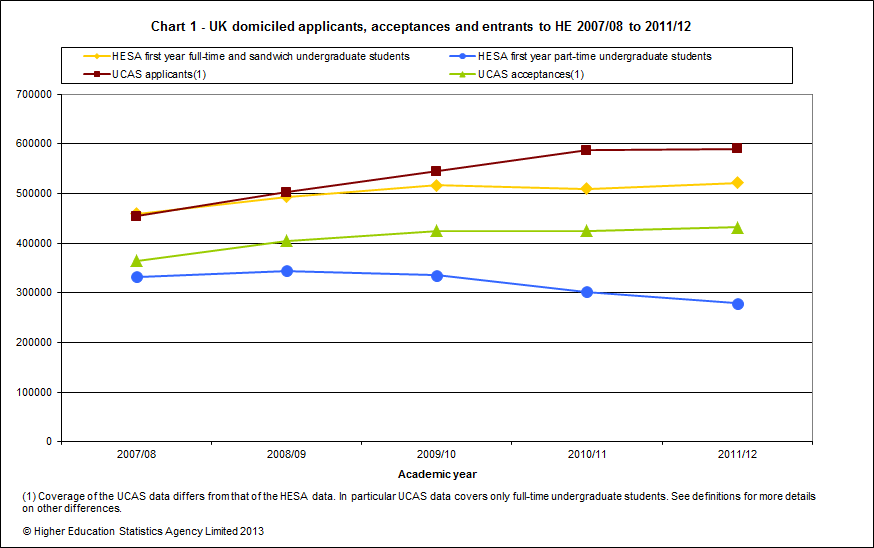
Student population
There were just under 2.5 million students studying for a HE qualification or for HE credit at UK HEIs in 2011/12. The number of HE students studying at UK HEIs had gradually increased from 2007/08 to 2010/11, however this number fell slightly in 2011/12. Overall since 2007/08 the percentage change was 8.3%, and since 2010/11 the percentage change was -0.2%.
An additional 54,425 students were known to be studying at further education (FE) level at UK HEIs, although this is likely to be an undercount as institutions are no longer required to return their FE data to HESA. Data on FE students at HEIs have therefore been excluded from the remainder of the introduction.
Table B provides more detail on students by level of study with comparisons between full-time and part-time, where full-time includes those following a full-time or sandwich programme. Since 2007/08, there has been a considerable drop in both full-time (-19.0%) and part-time (-23.5%) other undergraduate students, this may be in part because several institutions re-classified their nursing courses from a diploma of HE to a first degree during this time. For part-time postgraduate students the percentage change since 2010/11 was -7.0% compared with 2.5% percentage change since 2007/08. For context, Table B also includes data on HE level students studying at FE institutions in the UK.
Equivalent information on students studying at further education level can be found in the current Statistical First Release from The Data Service and the Department for Business, Innovation and Skills.
Over half (52.6%) of the 2,496,645 HE students were following a full-time first degree programme. The following pie chart illustrates the breakdown of HE students by level and mode of study.
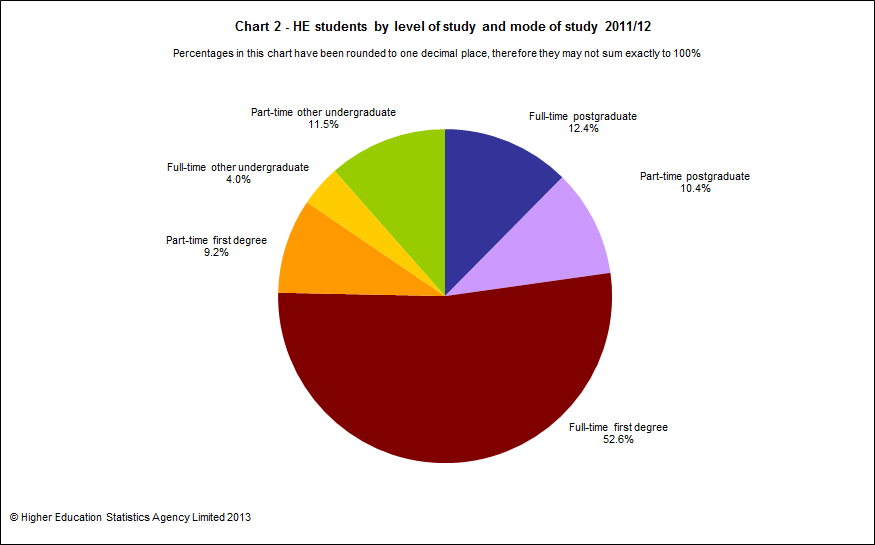
Gender and domicile
A higher percentage of female students (56.4%) were studying at UK HEIs than male students (43.6%). The gender imbalance was more noticeable among students studying part-time of whom 60.8% were female. For non-EU domicile students, a higher percentage were male (52.0%) than female (48.0%).
Table C illustrates the differences in student numbers by domicile, gender, level and mode of study.
Subject of study
Table D shows that the distribution of HE student numbers by subject varied by level of study.
High percentages of other undergraduate students studied subjects allied to medicine (26.1%) and in combined subject areas (13.7%). The high percentage in subjects allied to medicine can be explained because a qualification below first degree level is common in many health-related professions, especially nursing. Many Open University students may not initially have to declare their award intention and are reported as studying for institutional credit in the combined subject area. For both postgraduate and first degree students, the highest percentages were studying Business & administrative studies.
Chart 3 below provides the numbers of HE students by subject area and level of study.
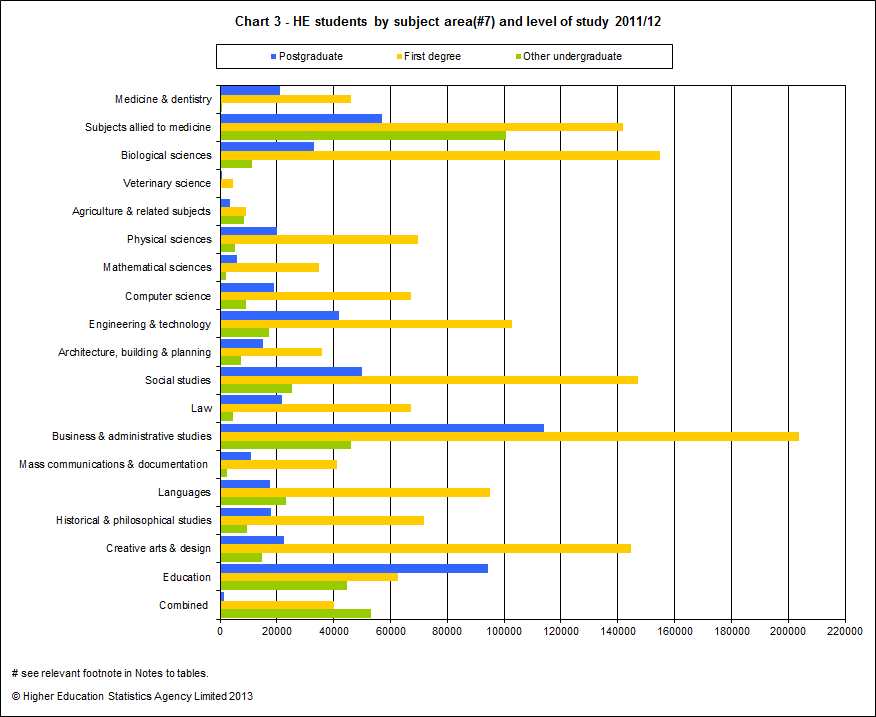
Qualifications obtained
In 2011/12 a total of 787,205 qualifications were awarded at HE level to students at UK HEIs. Of these, 33.5% were at postgraduate level, 49.7% were first degree qualifications and 16.8% were other undergraduate qualifications. Chart 4 illustrates this.
Over the period of 2007/08 to 2011/12 the total number of first degree qualifiers increased by 16.8%. This largely reflects the increasing numbers of entrants in earlier years feeding through the system. Table E provides a more detailed breakdown of qualifications obtained for the last five years.
Information on rates of completion for full-time first degrees are published separately in the ‘Projected Outcomes’ tables of the HESA Performance Indicators. These completion rates require two consecutive years’ data to produce so there is a time lag of one year between the latest data available (2011/12), and the latest completion rates (2010/11). The statistics show that the projected completion rate for full time first degrees increased slightly from 77.6% of 2004/05 entrants to 80.5% of 2010/11 entrants.
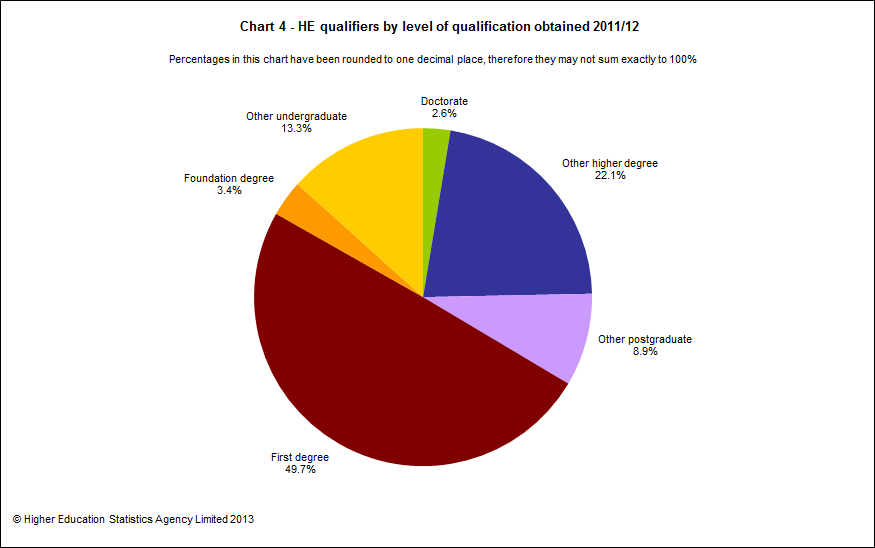
Destinations of leavers
Following a review of the Destinations of Leavers from Higher Education (DLHE) survey and consultation with government departments, the higher education (HE) sector and users of the data, the DLHE survey has been re-designed to collect richer information from leavers, particularly regarding their activities on the survey date. Leavers now report all the activities that they are undertaking on the census date and then indicate which one they consider to be most important to them. From these responses, destination categories are derived taking into account the most important activity and, in some instances, other activities the leaver is involved in. Read the changes to the survey document
Consequently, the DLHE survey has different definitions for the destination categories reported to those in previous years. Direct comparisons should not therefore be made with figures presented in previous years.
The coverage of the survey has been expanded to include additional HE qualifications and now includes non-EU domiciled leavers where it was previously restricted to UK and EU domiciled leavers only. The eligible DLHE population in 2011/12 was 699,330 leavers of which 131,940 were non-EU leavers. Surveying these leavers was undertaken as a pilot for 2011/12 with a clear distinction that the information collected should not be published until carefully reviewed. These leavers are therefore excluded from this publication.
The DLHE survey includes those qualifiers who completed their programmes during the academic year 2011/12. The reference date for those obtaining the qualification between 1 August 2011 and 31 December 2012 was 16 April 2012, and the reference date for those obtaining the qualification between 1 January 2012 and 31 July 2012 was 14 January 2013.
In 2011/12, of the 567,475 UK and other EU domiciled leavers within the eligible DLHE population, there were 411,005 qualifiers who provided information about their destinations. This gives a percentage with known destination of 72.4%. A further 28,290 qualifiers replied to the survey but explicitly declined to give information. Including the explicit refusals, the overall response rate for UK and other EU domiciled qualifiers was 77.4%. Table E provides a breakdown of leavers’ activity by level of qualification obtained.
The following pie charts show comparatively the percentage of leavers by activity for postgraduate, first degree and other undergraduate leavers. Around two-thirds (67.9%) of postgraduate leavers entered full-time work only. The percentage was closer to a half (52.5% and 43.4%) for first degree and other undergraduates respectively. First degree leavers were more likely to be unemployed (8.5%) than postgraduates (5.7%) and other undergraduates (4.3%). Over a third of other undergraduates were engaged in study, either through a combination of work and further study (15.3%) or further study only (22.3%).
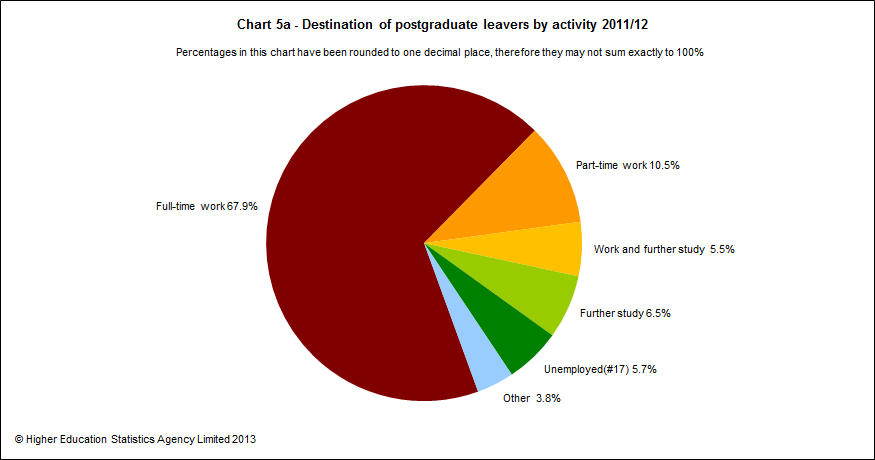
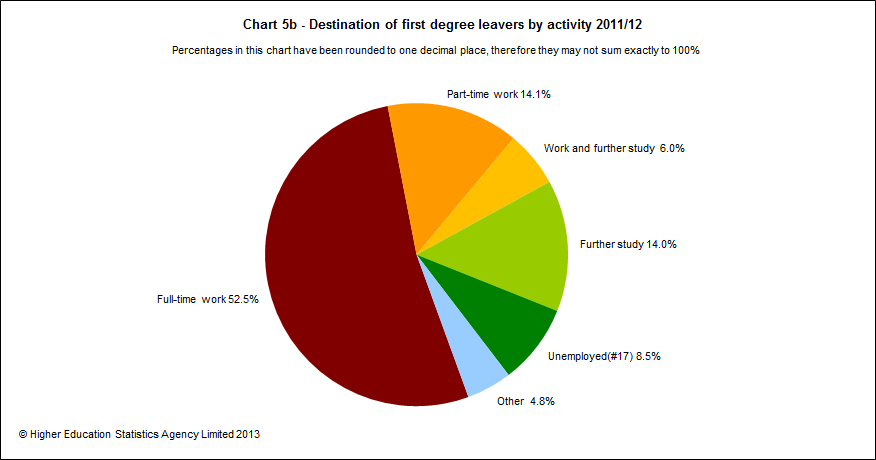
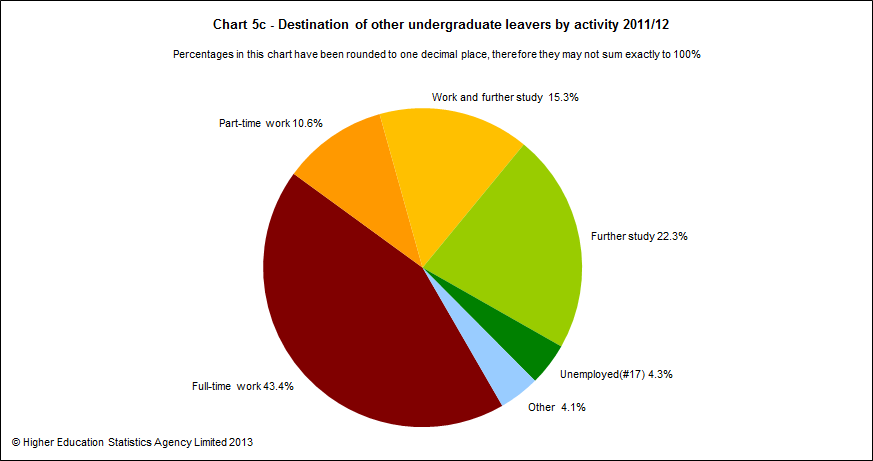
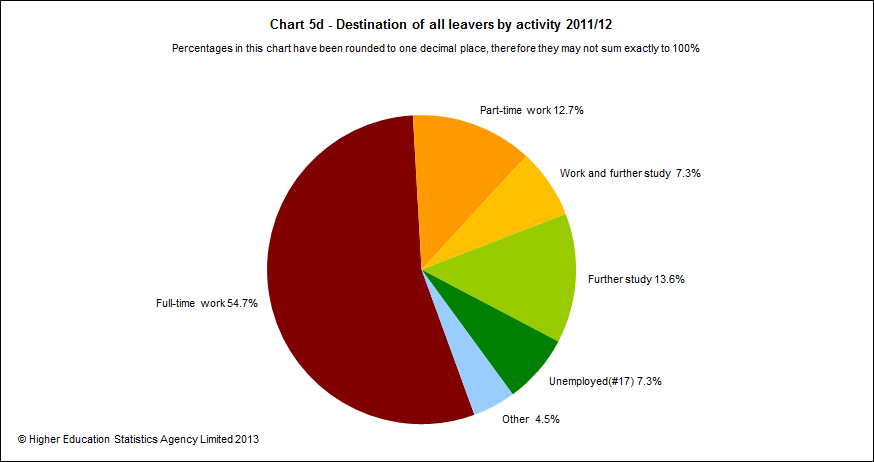
Table G and Chart 6 show how the distribution of leavers by activity varies for each subject area for full-time first degree leavers. Unemployment rates for full-time first degree leavers whose destinations were known varied between subjects, ranging from those which have traditionally low rates of unemployment, such as Medicine & dentistry (0.2%), Education (4.0%) and Subjects allied to medicine (5.2%) to those with higher rates of unemployment, such as Computer science (14.0%), Mass communications & documentation (12.3%) and Creative arts & design (11.3%).
Full-time first degree leavers having studied Law were the most likely to be engaged in some form of further study (44.0%), which is a common path to qualification in that profession. In contrast, 92.2% of full-time first degree leavers who studied Medicine & dentistry and 88.3% who studied Veterinary science went into employment.
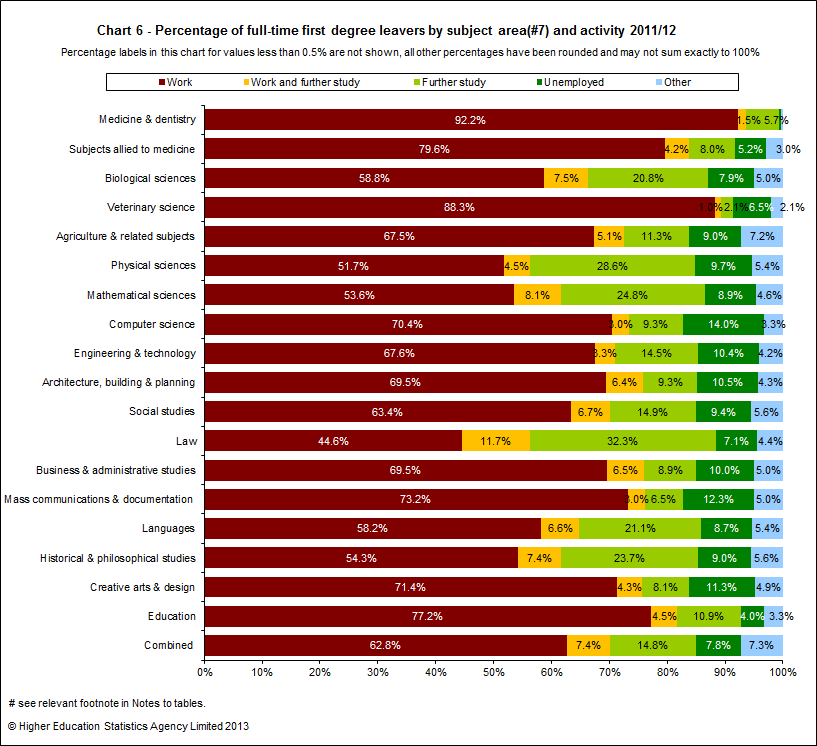
Staff
The HESA Staff Record covers all academic and non-academic staff who have a contract of employment with a UK higher education institution (HEI), or for whom the HEI is liable to pay Class 1 National Insurance contributions.
On 1 December 2011, there were in total, but excluding those staff on atypical1 contracts, 378,250 staff, of whom 181,385 were academic and 196,860 were non-academic. In addition, there were 187,865 staff on atypical contracts.
The remainder of the staff figures exclude atypical staff. Table H provides a breakdown of academic staff by activity and mode of employment for the last five years.
Overall student and staff numbers have both increased steadily over the last five years, although there has been a decrease of 0.9% in staff numbers in the last year. Academic staff numbers increased by 0.1% in the last year and non-academic staff numbers decreased by 1.9%.
Chart 7 illustrates the increasing trend of both students and academic staff over a five year period. It should be noted that the axis scale for staff differs from that of students in order to express both trends on the same chart.
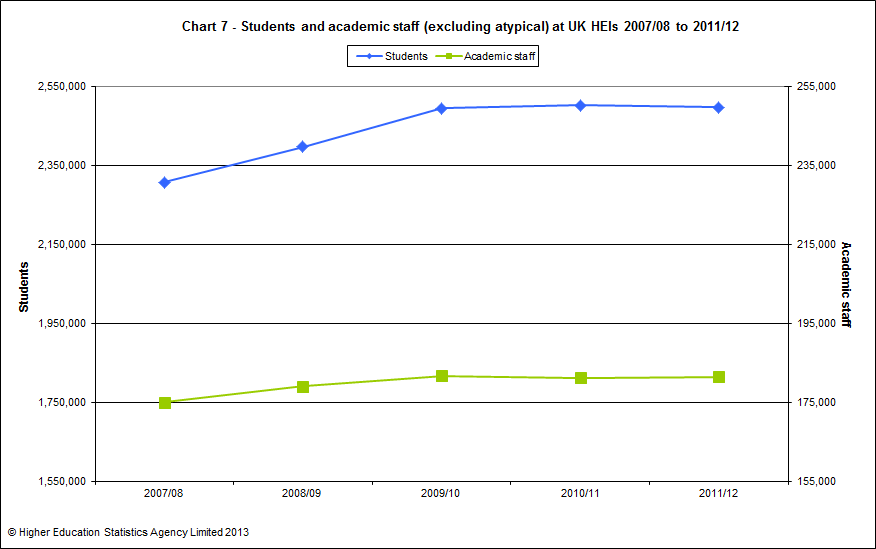
Table I below shows academic staff by academic employment function, gender, mode of employment and terms of employment for 2011/12. Overall, there was a higher percentage of male academic staff than female. However, higher percentages of part-time academic staff were female. This was true for both open-ended/permanent and fixed-term contracts.
Chart 8 below illustrates the percentages of open-ended/permanent and fixed-term contract academic staff by academic employment function, mode of employment and gender. It can be seen that staff engaged in both teaching and research were much more likely to be employed on open-ended/permanent contracts than those undertaking only research.
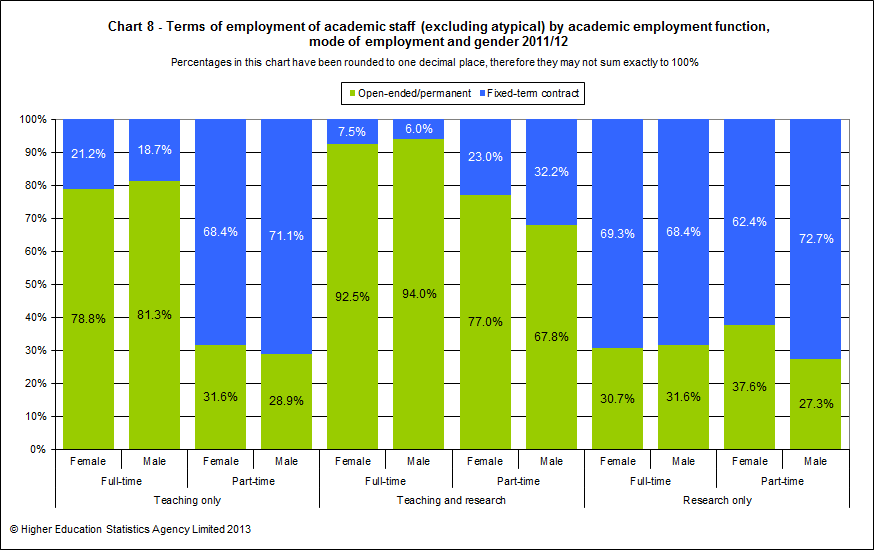
Finance
The finance data collected by HESA from UK HEIs covers income and expenditure. Over the last five years, income and expenditure have gradually increased at a similar rate, tapering off during the last couple of years. Net income has increased at a slightly higher rate in cash terms (19.0% increase since 2007/08) than expenditure (16.6% increase since 2007/08) with a HE sector surplus across all years.
Table J provides a time series of the various income and expenditure streams for the last five years.
Chart 9 illustrates the percentage change of the various sources of income over the same period. In particular, the percentage of income from tuition fees and education contracts has increased from 26.7% in 2007/08 to 34.7% in 2011/12.
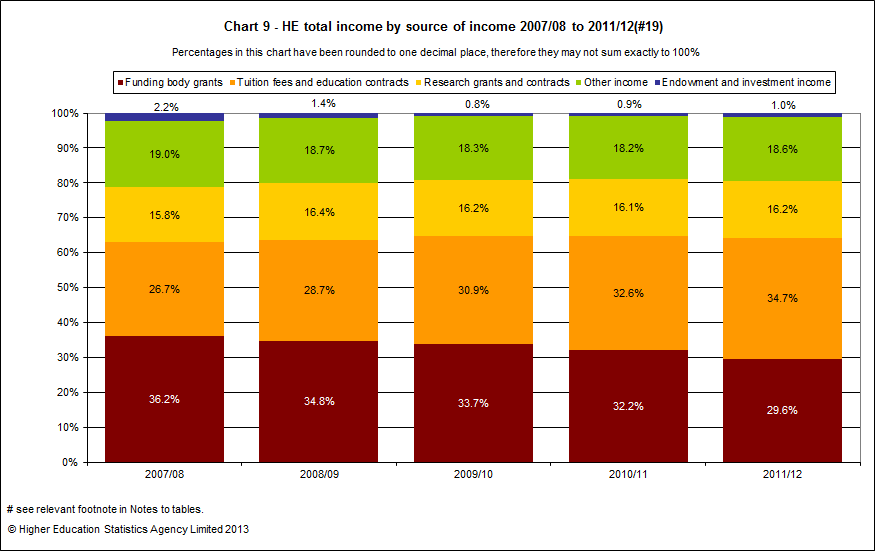
Student Loans
Table K provides information on income from course fees of full-time UK and EU domicile undergraduates (source: HESA) alongside tuition fee loans and maintenance loans paid to HE students (source: SLC). The difference in coverage means that data from these two sources are not directly comparable; however, the figures allow some trend comparisons to be made. Although income of HEIs and loans paid to HE students have all increased over time, the tuition fee loans paid to HE students have increased at a faster rate.
1 See Definitions, Section F for explanation of atypical staff.
© Higher Education Statistics Agency Limited 2013
